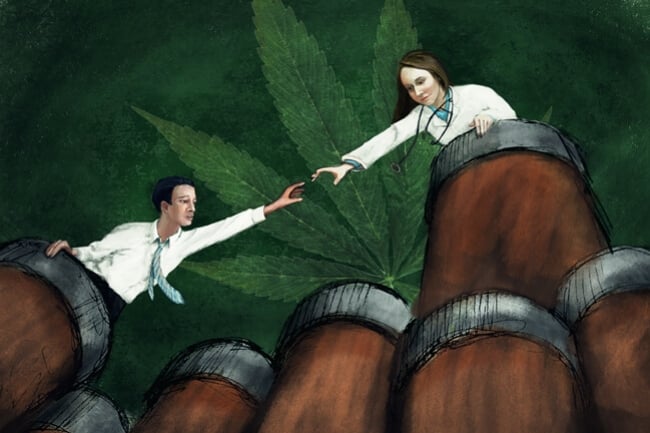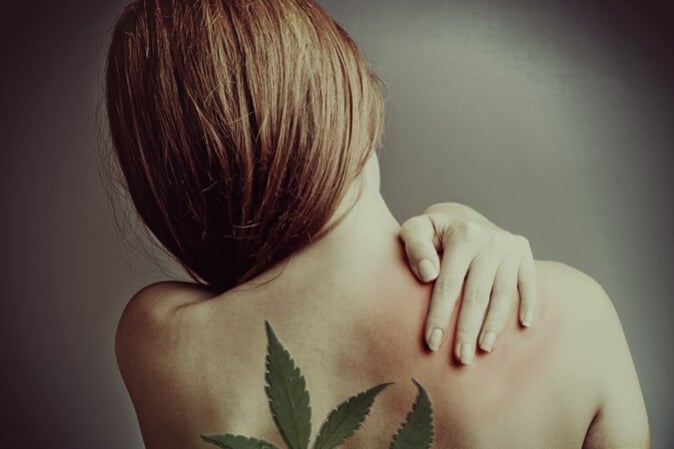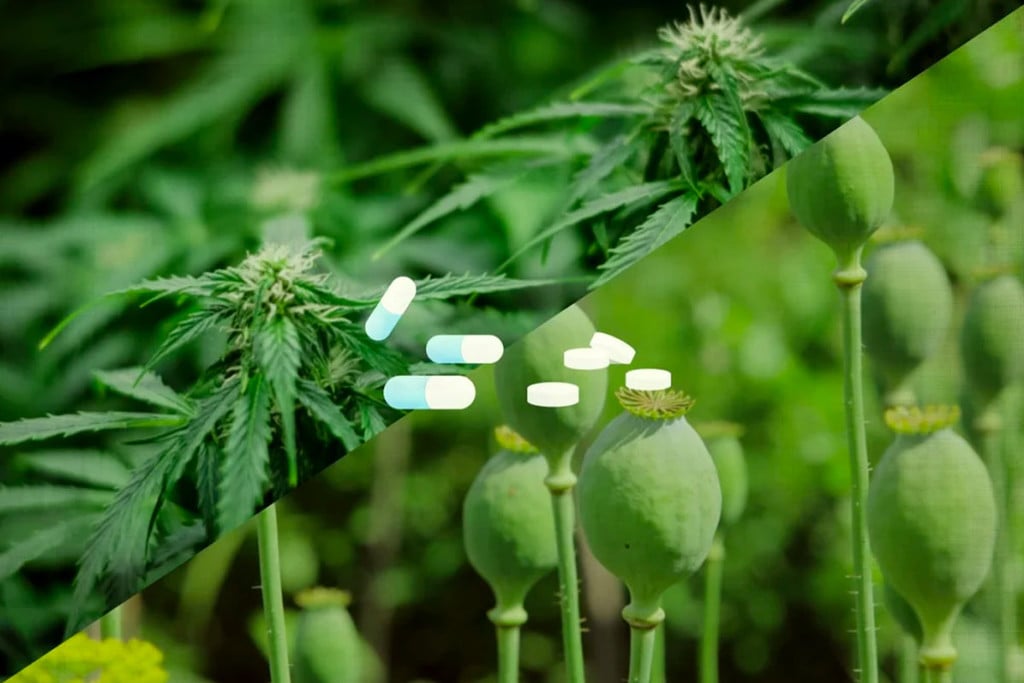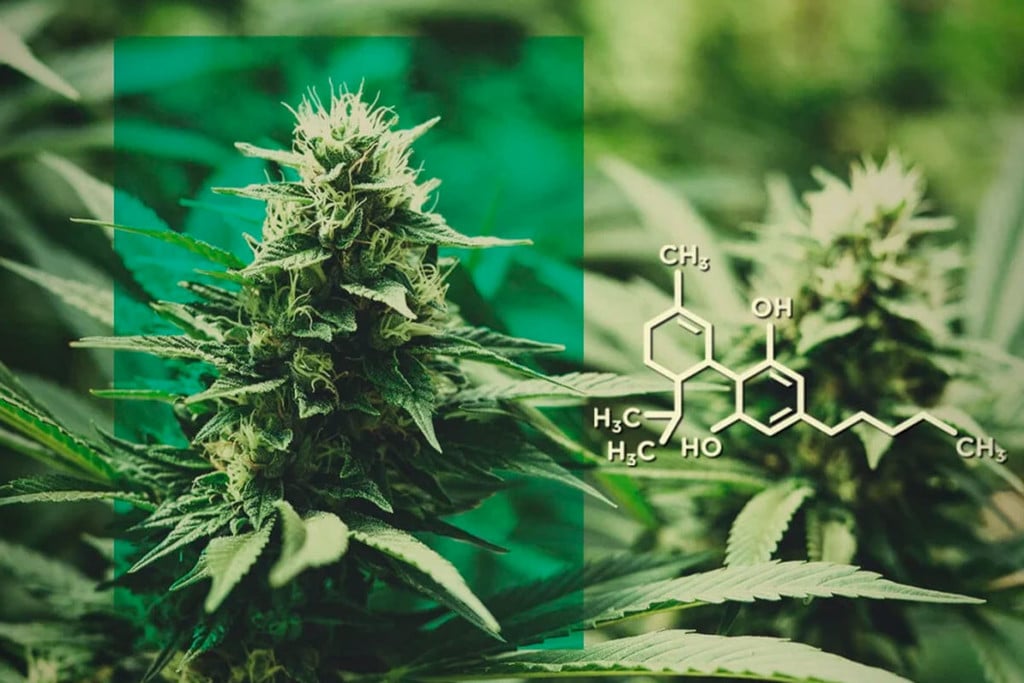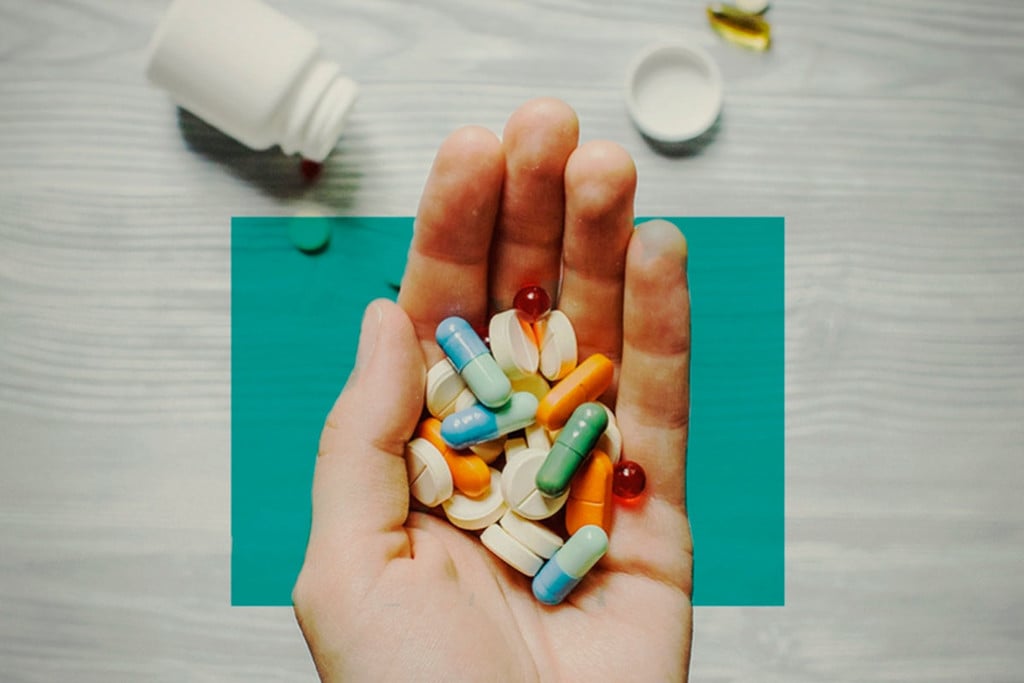.
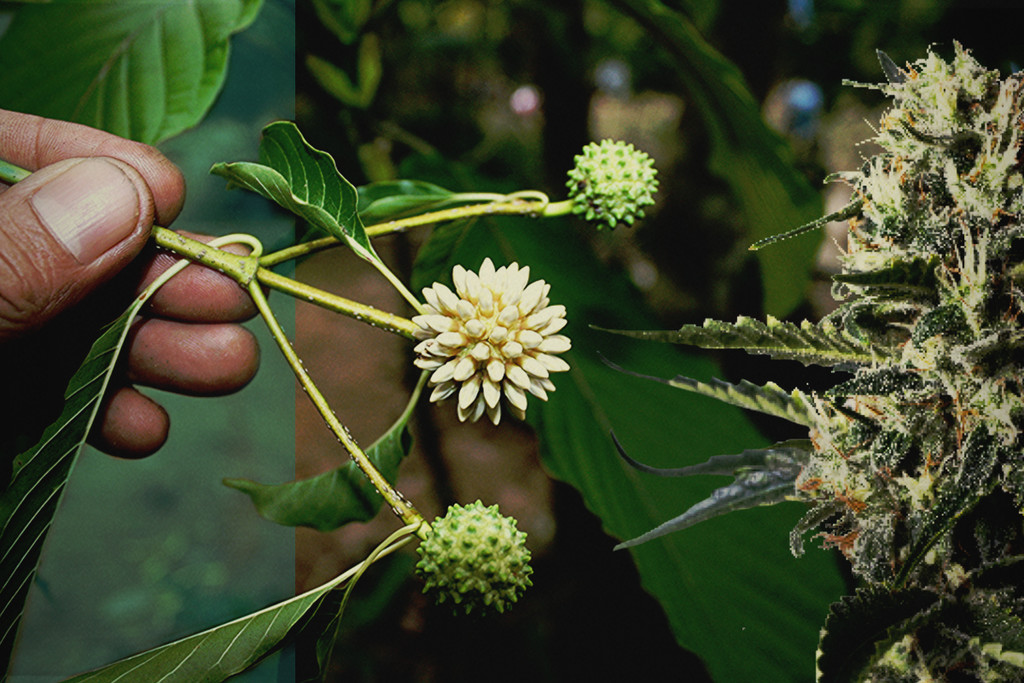
Kratom vs CBD: Discover the Differences
CBD and kratom are two popular botanical products, but their similarities end there. CBD and the active components found within kratom work very differently in the body. While the former exerts its effects largely via the endocannabinoid system, the latter has a high affinity for opioid receptors. Delve deeper into their key differences below.
Contents:
Although just a plant, kratom has generated plenty of controversy due to its psychoactive effects. While CBD doesn’t get you high, it does stem from one of the most vilified plants on Earth. Reputation aside, researchers are looking into how these substances work in the body, testing them in models of myriad health conditions.
WHAT IS KRATOM?
Kratom is a botanical product known scientifically as Mitragyna speciosa. The kratom plant grows naturally in Malaysia, Indonesia, Thailand, and Papua New Guinea. In Southeast Asian countries such as these, it has a history of use as an opium substitute. In the global market, it has been most commonly used to manage pain, boost energy, and as a dietary supplement.
Kratom has been traditionally used as both a textile and a medicine. Mytragina is a genus in the Rubiaceae family. Similarly to some other plants in the family, like coffee, kratom acts as a stimulant at low doses. These effects are what makes it successful as an energy booster and dietary supplement. However, at high doses, Mytragina exhibits characteristics similar to those of opiates. Other than the poppy plant, and akuamma seeds, kratom is the only natural source of opioid alkaloids in the world.
For thousands of years, kratom has been used similarly to cannabis. However, unlike cannabis, it never really caught on with popular culture. Nevertheless, in recent years, its usage in the United States and Europe has spiked. However, so too have concerns about its safety and legality.
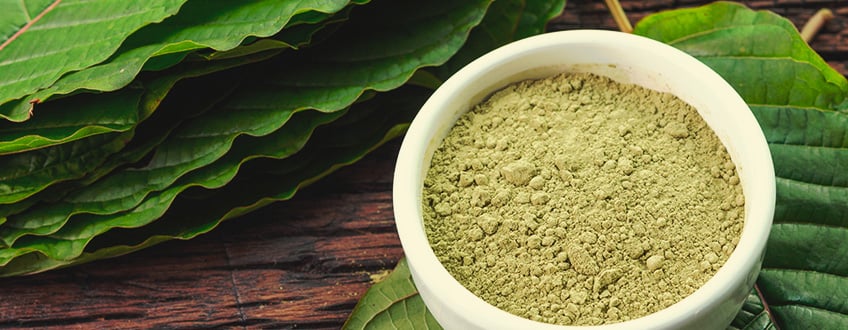
WHAT CAN KRATOM BE USED FOR?
Kratom has a long history as a remedy for a wide number of conditions and symptoms. In the past, it has been used to treat problems such as fever, coughing, muscle pain, diarrhoea, hypertension, fatigue, and other ailments. In the modern age, it is commonly used to treat chronic pain, anxiety, opiate withdrawal, and as an energy booster. Despite being banned in several countries, it is still regularly consumed at social gatherings in Southeast Asia.
An effective dose of kratom can deliver users such benefits as lowering anxiety, decreasing pain, inducing sedation, and increasing energy and productivity. Unlike cannabis, kratom does not provide immediate relief. The effects of kratom are typically felt within an hour.
Pain relief is one of the most common uses for kratom. A recent review of medical studies found that kratom can reduce pain while also inducing relaxation and boosting the immune system. Additionally, according to an online survey conducted by the Pain News Network in collaboration with the American Kratom Association, over 90% of participants found kratom to be effective in the relief of pain.
Kratom has long been used to treat substance withdrawal, especially from opioids. The opioid crisis in North America has been at least partially responsible for kratom’s rise in popularity. Many addicts have found kratom to be incredibly effective in helping to wean them off of more powerful opioids like heroin, oxycodone, and fentanyl. Some have been able to use kratom to eradicate the symptoms of opioid withdrawal until they disappear altogether. Kratom’s ability to act as an opioid substitute allows drug users to kick the habit of heavy narcotics and return to a normal life.
Some individuals have reported success using kratom in the treatment of anxiety disorders. Conditions like post-traumatic stress disorder (PTSD) and social anxiety disorder (SAD) have been successfully treated with kratom. It is also capable of producing an anti-inflammatory effect. This may make it an effective treatment for joint and bone-related pain. However, more clinical research is required in order to fully endorse kratom as a treatment for such conditions.
HOW DOES KRATOM WORK?
In its natural form, kratom can be chewed, smoked, or steeped in tea. Most commonly, kratom is ground into a powder and mixed with a liquid, usually warm water. Unlike with cannabis, kratom does not need to be heated in order to be activated. As such, it can be consumed in its raw form, usually via a capsule. Kratom can also be mixed with other liquids or foods so as to make it easier to ingest. One of the more common and convenient foods used for mixing kratom is yoghurt.
At least 25 individual alkaloids have been identified and extracted from the leaves of the kratom plant. The dominant indole alkaloid in kratom is mitragynine (MG). It is responsible for most of kratom’s analgesic capability. When compared to other painkillers, mitragynine’s potency as a painkiller is about as effective as codeine. Three other alkaloids in the plant have been found to directly activate opioid receptors in the body and brain.
MG is actually less effective as a single-molecule isolate than when it is consumed as a whole-plant extract. This is because whole-plant extracts contain many more biologically active compounds, like 7-hydroxymitragynine. This compound is a strong analgesic that interacts with the mu-opioid receptor, despite being structurally different from other opioids. It does not bind to opioid receptors, and its effects differ from those of pharmaceutical opioids.
Research has shown that kratom’s physiological properties exert themselves through neurotransmitter systems, in addition to its unique interactions with opioid receptors. Kratom affects neurotransmitters like dopamine, serotonin, and GABA.
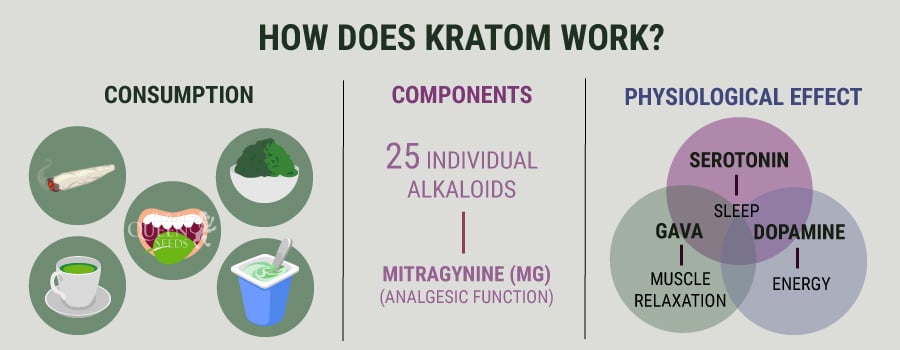
SIDE EFFECTS AND RISKS
Kratom’s ability to treat a wide range of conditions comes with some downsides. The most common side effects of kratom are the same as those of opioids. They include stomach pains, vomiting, itching, nausea, dry mouth, and lack of appetite. However, the risk of encountering these side effects is much lower than with other opioids. It has also been blamed for causing other, more serious issues such as seizures, arrhythmia, liver damage, and psychosis. However, documentation and thorough investigation of kratom’s role in these conditions is rare.
Almost all deaths involving kratom also involve other narcotics or mind-altering substances. This suggests that kratom can be dangerous if mixed with other substances, including over-the-counter medications. Studies show that kratom has the ability to alter the human metabolism of various substances, potentially making them more dangerous.
As such, it is recommended to only use kratom by itself, without any added substances.
According to one study, the potential to overdose on kratom alone does exist. However, it would require an extremely large dose. As such, overdosing on kratom is practically unheard of because vomiting would be naturally induced before such a point is reached.
While kratom may be useful in treating opioid addiction, it also has addictive potential itself. A 2014 survey of 293 people found that nearly all participants showed signs of addiction following the regular use of kratom for 6 months. Pain, sleeping difficulty, and anger were among the most common physical and psychological symptoms reported.
Recently, adulterants and additives in kratom products have become a source of worry and criticism. This is not an issue in Asian countries where customers can purchase the pure product from local producers. However, additives are not uncommon in kratom products sold in the West. Some products are altered with caffeine, synthetic opioids, or other pharmaceuticals. The biggest danger with kratom comes not from the drug itself, but from other drugs being mixed with it.
IS KRATOM LEGAL?
The legality of kratom differs from country to country, and state to state. Countries like Poland, Germany, and New Zealand have declared it a controlled substance. Others like Australia, Myanmar, and Thailand have made it outright illegal. Be sure to check the legal status of kratom in your country, region, and city, as it may differ from jurisdiction to jurisdiction.
When it comes to the United States, kratom’s legal status is constantly under threat. Its close relation to opioids has drawn criticism from US lawmakers. In 2016, the US Drug Enforcement Agency (DEA) made its first attempt to ban kratom from the country. In 2017, the US Food and Drug Administration (FDA) recommended that kratom be classed as a Schedule I drug alongside other opioid narcotics. Following public outcry, the DEA and FDA have chosen not to act on these recommendations, meaning that kratom is still legal at the federal level.
Numerous states have taken the initiative to ban kratom locally. States like Alabama, Indiana, and Tennessee, among others, have opted to make kratom illegal. Certain American cities, including Denver, San Diego, and Sarasota, have also decided to make kratom illegal within their jurisdiction.
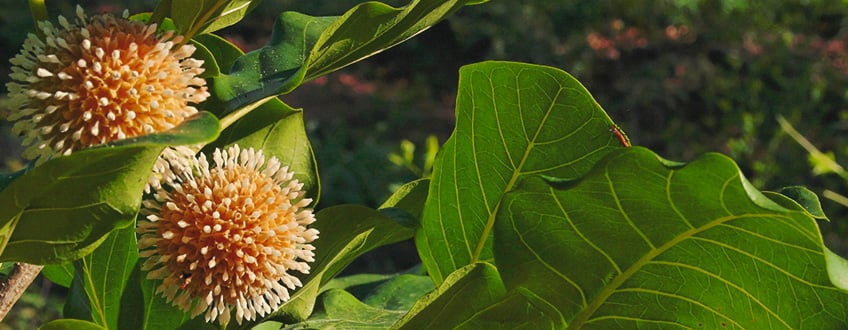
WHAT IS CBD?
Cannabidiol (CBD) is a cannabinoid found in the cannabis plant. It is the second most important cannabinoid alongside tetrahydrocannabinol (THC). However, unlike THC, it does not appear to cause mind-altering psychotropic effects according to a review[1] by the WHO. CBD is typically derived from hemp, thanks to its high CBD content. It is usually extracted and converted into a wide range of products such as tinctures, capsules, edibles, and vapeable oils. High-CBD cannabis strains can also be smoked or vaped in their plant form.
CBD products can sometimes also contain other cannabinoids (including THC). This kind of product is known as “full-spectrum CBD”. Dr Ethan Russo, a leading figure in cannabis research suggests[2] that cannabinoids are more effective together. In the US, these products are considered to be legal as long as they contain less than 0.3% THC. In Europe, the same is true so long as there is less than 0.02%. The legally allowed THC percentage may be different in other countries. CBD can also be purchased and consumed as a single-molecule isolate. CBD isolate contains no other cannabinoids or terpenes.
WHAT IS CBD USED FOR?
CBD is widely viewed and available as a supplement. However, it is being investigated for a number of applications by scientific institutions.
Studies have implicated cannabidiol as having potential in the management of epilepsy[3]. CBD entered the mainstream in 2013 when Charlotte Figi[4], a child from Colorado, vastly reduced the number of seizures experienced by using cannabidiol oil. Since then, medical research has strengthened the case for CBD’s use in managing rare and untreatable epileptic conditions.
The science surrounding CBD remains limited. But ambitious studies are pitching the cannabinoid against models of common conditions, including:
- PTSD[5]
- Seasonal affective disorder (SAD)[6]
- Insomnia and anxiety[7]
- Cannabis withdrawal syndrome[8]
The endocannabinoid system is emerging as a potential therapeutic target in musculoskeletal conditions, and researchers are now looking into how blends of CBD and THC impact joint conditions[9] such as rheumatoid arthritis.
HOW DOES CBD WORK?
Scientific literature has identified over 65 molecular targets and pathways of CBD. Unlike THC, CBD has little binding affinity with the cannabinoid receptors CB1 and CB2. Instead of binding to them, it acts upon them indirectly. CBD is thought to work through numerous non-cannabinoid ion channels and receptors to achieve this.
CBD produces its effects by activating receptors like the TRPV1, using them to manipulate specific bodily functions through the endocannabinoid system. CBD exerts some of its other effects by increasing the amount of anandamide available in the body.
WHAT ARE THE SIDE EFFECTS/RISKS OF CBD USE?
The World Health Organisation recently concluded that CBD appears non-addictive and non-psychotropic. In fact, Research[10] in The Journal of Neuroscience found CBD to be particularly useful in addressing substance withdrawal by restricting the release of dopamine, the pleasure molecule. The study found that CBD interacts with signalling in our mesolimbic dopamine pathway, attuning our response to stimuli.
CBD’s most common side effects include nausea, vomiting, diarrhoea, dry mouth, dizziness, drowsiness, and changes in mood or appetite. The compound may also interact with a number of other medications, including epileptic medications. Make sure to talk to your doctor if you intend to use CBD and prescription medication simultaneously. It is also recommended that pregnant women and nursing mothers avoid consuming any cannabis products altogether.
IS CBD LEGAL?
The legality of CBD will differ depending on the jurisdiction. The federal legalization of hemp in the United States has made CBD a grey area. In theory, if CBD products contain less than 0.3% THC, they should be legal. However, different jurisdictions may have different rules on the legality of CBD. You should always check the laws in your home state before making a decision to use CBD—to be on the safe side.
When it comes to Europe, CBD is legal assuming it's derived from hemp and contains less than 0.02% THC. Countries like the UK, Italy, Austria, Belgium, and Romania are just a few where CBD is legal to buy and use.
HOW DOES CBD COMPARE TO KRATOM?
The main differences between kratom and CBD exist at the molecular level. Kratom and CBD both contain different molecular compounds. As such, despite the fact that they sometimes produce similar effects, they differ from one another in the ways they work to produce such effects.
CBD and kratom both potentially impact pain perception. CBD’s role in affecting various kinds of pain, such as inflammation-related pain and neuropathic pain, is currently being investigated in laboratory studies[11].
| CBD | |
|---|---|
| Molecular compounds C21H3002 |
|
| Effects Analgesic, anti-inflamatory, antiemetic... |
|
| Addiction No |
|
| Mixing with medicine No |
| KRATOM | |
|---|---|
| Molecular compounds C23H3002 |
|
| Effects Analgesic, calmness, cough suppression... |
|
| Addiction Yes |
|
| Mixing with medicine No |
| MARIJUANA | |
|---|---|
| Molecular compounds C21H3002 |
|
| Effects Euphoria, relaxation, heightens sensory perception... |
|
| Addiction Yes |
|
| Mixing with medicine Depends of which medicine. |
| How Does CBD Compare To Kratom And Marijuana? | ||||||||
|---|---|---|---|---|---|---|---|---|
| CBD | KRATOM | MARIJUANA | ||||||
| Molecular compounds |
C21H3002 | C23H3002 | C21H3002 | |||||
| Effects | Analgesic, anti-inflamatory, Antiemetic... | Analgesic, calmness, cough suppression... | Euphoria, relaxation, heightens sensory perception... | |||||
| Addiction | No | Yes | Yes | |||||
| Mixing with medicine |
No | No | Depends of which medicine. | |||||
When it comes to kratom, there simply is not enough available research to conclusively say which types of pain it treats. Unlike CBD, kratom’s effectiveness comes from anecdotal evidence, not clinical research. However, this does not necessarily make it any less effective. Despite its murky legal status, many people self-medicate with kratom for pain relief.
Kratom and CBD both show promise for the treatment of substance withdrawal. However, they treat the condition in very different ways. Kratom directly interacts with opioid receptors, whereas CBD does not directly interact with cannabinoid receptors CB1 and CB2. Kratom is useful in the treatment of opioid addiction because it has so many similar properties to opioids. As such, kratom is considered to be an opioid substitute.
How does CBD perform in cases of substance abuse? Institutions are pouring money into studies in hopes of finding an answer. A study published in 2021 in the journal Cannabis and Cannabinoid Research discusses the relationship of CBD with opioid withdrawal[12]. Other research efforts are exploring the role of CBD in decreasing the addictive use of cannabis[13]—a testament to the versatility of a single plant.
When comparing side effects, the most significant difference is kratom’s potential for addiction. Research has conclusively demonstrated that kratom users suffer side effects similar to those induced by other opioids. The main difference is in the severity and length of the side effects.
Kratom is known to make users sleepy, especially at high doses. CBD does not affect drowsiness or cognitive ability. Consequently, you should be careful when consuming kratom since you will not be able to engage in specific activities, like driving. By comparison, you can expect to do just about anything on CBD that you could do without it.
CBD is preferred by some because of the wide variety of forms that it comes in. Sophisticated extraction processes allow CBD to be infused into a variety of convenient forms including foods, liquids, and capsules.
Kratom is much less safe to mix with other medications or narcotic substances, including over-the-counter prescriptions. Deaths involving kratom almost always involve multiple substances.
HOW DOES KRATOM COMPARE TO MARIJUANA?
When it comes to whole-plant cannabis, the comparison becomes more complex because of strains. Both kratom and marijuana are bred in a variety of strains, impacting the kinds of effects they produce.
The most recommended kratom strains for pain relief are red vein Bali, Borneo, or Indo kratom. When it comes to marijuana, the best strains for pain relief are usually heavy indicas like Afghan and Hindu Kush.
When consumed at a low dose, these kratom strains can exercise their effects while still maintaining cognitive ability. At higher doses, they can completely eliminate pain, but their cognitive effects will become more unpredictable. When consuming indica cannabis strains at higher doses, the effects are similar to kratom. Its effects on pain will be more complete, but cognitive impairment will be obvious. To combat this, some medical marijuana users prefer to microdose with amounts ranging from 0.1 to 0.3 grams. This allows them to get some of the pain-relieving effects without sacrificing too much mental ability.
Both kratom and marijuana are known to, at least temporarily, provide relief from anxiety. Marijuana users need to be extra careful with the strains they choose for anxiety relief. Strong sativa strains can actually produce the opposite effect, increasing anxiety. Sometimes, this effect can be so profound that users experience anxiety or panic attacks. By comparison, kratom is not known to worsen anxiety, just relieve it.
Kratom’s legal status makes it safer to acquire and use than marijuana in many places in the world, although not everywhere. If legality is a concern for you, then kratom is often the better option of the two. However, as the legalization of medical and recreational marijuana continues to spread, this may not continue to be the case.
- https://www.who.int/medicines/access/controlled-substances/CannabidiolCriticalReview.pdf
- The Case for the Entourage Effect and Conventional Breeding of Clinical Cannabis: No “Strain,” No Gain https://www.ncbi.nlm.nih.gov
- Frontiers | Potential Clinical Benefits of CBD-Rich Cannabis Extracts Over Purified CBD in Treatment-Resistant Epilepsy: Observational Data Meta-analysis | Neurology https://www.frontiersin.org
- The case for medical marijuana in epilepsy - PubMed https://www.ncbi.nlm.nih.gov
- Effectiveness of Cannabidiol Oil for Pediatric Anxiety and Insomnia as Part of Posttraumatic Stress Disorder: A Case Report https://www.ncbi.nlm.nih.gov
- SAGE Journals: Your gateway to world-class journal research https://journals.sagepub.com
- Effectiveness of Cannabidiol Oil for Pediatric Anxiety and Insomnia as Part of Posttraumatic Stress Disorder: A Case Report https://www.ncbi.nlm.nih.gov
- Cannabidiol for the treatment of cannabis withdrawal syndrome: a case report - PubMed https://www.ncbi.nlm.nih.gov
- Preliminary assessment of the efficacy, tolerability and safety of a cannabis-based medicine (Sativex) in the treatment of pain caused by rheumatoid arthritis - PubMed https://www.ncbi.nlm.nih.gov
- Cannabidiol Counteracts Amphetamine-Induced Neuronal and Behavioral Sensitization of the Mesolimbic Dopamine Pathway through a Novel mTOR/p70S6 Kinase Signaling Pathway - PubMed https://www.ncbi.nlm.nih.gov
- Sativex: clinical efficacy and tolerability in the treatment of symptoms of multiple sclerosis and neuropathic pain - PubMed https://www.ncbi.nlm.nih.gov
- https://www.liebertpub.com/doi/full/10.1089/can.2021.0089
- Cannabidiol Oil for Decreasing Addictive Use of Marijuana: A Case Report https://www.ncbi.nlm.nih.gov


























